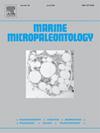Response of calcareous nannofossils during the danian-thanetian isotopic events in the Elles Section, Central Tunisia
IF 1.5
4区 地球科学
Q2 PALEONTOLOGY
引用次数: 0
Abstract
A high resolution quantitative study of calcareous nannofossils from the Elles section in Central Tunisia (North Africa) was conducted to assess local phytoplankton paleocommunities and infer paleoclimatic conditions. This research introduces a refined subdivision of the conventional NP4 nannofossil zone into six finer intervals (NTp6, NTp7A-B, NTp8A-C), a first for Tunisia, enhancing the biostratigraphic resolution of Paleocene stratigraphy in the region. The assemblages within these subzones exhibit moderate to good preservation and correlate globally with established Tethyan biozonations. Three key isotopic events were identified: The Dan-C2 event, characterized by a negative δ13C shift at the base of the NP2 Zone, associated with a significant increase in oligotrophic and warm-water taxa; the Latest Danian Event (LDE), which is divided into Pre- and Post-LDE intervals. The Pre-LDE interval is marked by a short-lived negative δ13C excursion within the lowermost part of NTp7A Subzone boundary, accompanied by a notable decline in the diversity and richness of calcareous nannofossils. The third event, the Selandian-Thanetian Transition Event (STTE), occurs at the base of NP7/8 and is biostratigraphically defined by the Lowest Occurrence (LO) of Discoaster mohleri, with a replacement of R-mode taxa by species adapted to warmer, more oligotrophic conditions. The Danian-Selandian transition is clearly delineated by a glauconite-rich hard marl layer (upper NTp8C). This integrated stratigraphic study provides high-resolution biostratigraphy and critical insights into paleoenvironmental changes during this period. The paleoenvironment shifted from warm, oligotrophic conditions during the events to cooler, eutrophic waters both before and after. These findings suggest that the three bioevents may correspond to an early Paleocene hyperthermal episode.
突尼斯中部埃莱斯剖面钙质纳米化石在达旦-达旦-达旦同位素事件中的响应
对北非突尼斯中部Elles剖面的钙质纳米化石进行了高分辨率定量研究,以评估当地浮游植物古群落并推断古气候条件。本研究首次将常规NP4纳米化石带精细细分为6个更精细的层段(NTp6、NTp7A-B、NTp8A-C),提高了该地区古新世地层的生物地层分辨率。这些亚带内的组合表现出中度至良好的保存,并与已建立的特提斯生物带具有全球相关性。确定了3个关键同位素事件:Dan-C2事件以NP2带底部负δ13C位移为特征,与贫营养和暖水类群的显著增加有关;最新的大年事件(LDE),分为大年事件前和大年事件后。前lde期段在NTp7A亚带边界最下端出现了短暂的负δ13C偏移,钙质纳米化石的多样性和丰富度明显下降。第三个事件是Selandian-Thanetian Transition event (STTE),发生在NP7/8的底部,在生物地层学上由disaster mohleri的最低发生率(LO)定义,r型分类群被适应更温暖、更少营养条件的物种取代。富含海绿石的硬泥灰岩层(NTp8C上部)清晰地描绘了达尼安-塞兰地过渡。这一综合地层学研究提供了高分辨率的生物地层学和对这一时期古环境变化的重要见解。在事件发生前后,古环境从温暖的贫营养条件转变为较冷的富营养化水域。这些发现表明,这三个生物事件可能对应于一个早古新世的高温事件。
本文章由计算机程序翻译,如有差异,请以英文原文为准。
求助全文
约1分钟内获得全文
求助全文
来源期刊

Marine Micropaleontology
地学-古生物学
CiteScore
3.70
自引率
15.80%
发文量
62
审稿时长
26.7 weeks
期刊介绍:
Marine Micropaleontology is an international journal publishing original, innovative and significant scientific papers in all fields related to marine microfossils, including ecology and paleoecology, biology and paleobiology, paleoceanography and paleoclimatology, environmental monitoring, taphonomy, evolution and molecular phylogeny. The journal strongly encourages the publication of articles in which marine microfossils and/or their chemical composition are used to solve fundamental geological, environmental and biological problems. However, it does not publish purely stratigraphic or taxonomic papers. In Marine Micropaleontology, a special section is dedicated to short papers on new methods and protocols using marine microfossils. We solicit special issues on hot topics in marine micropaleontology and review articles on timely subjects.
 求助内容:
求助内容: 应助结果提醒方式:
应助结果提醒方式:


